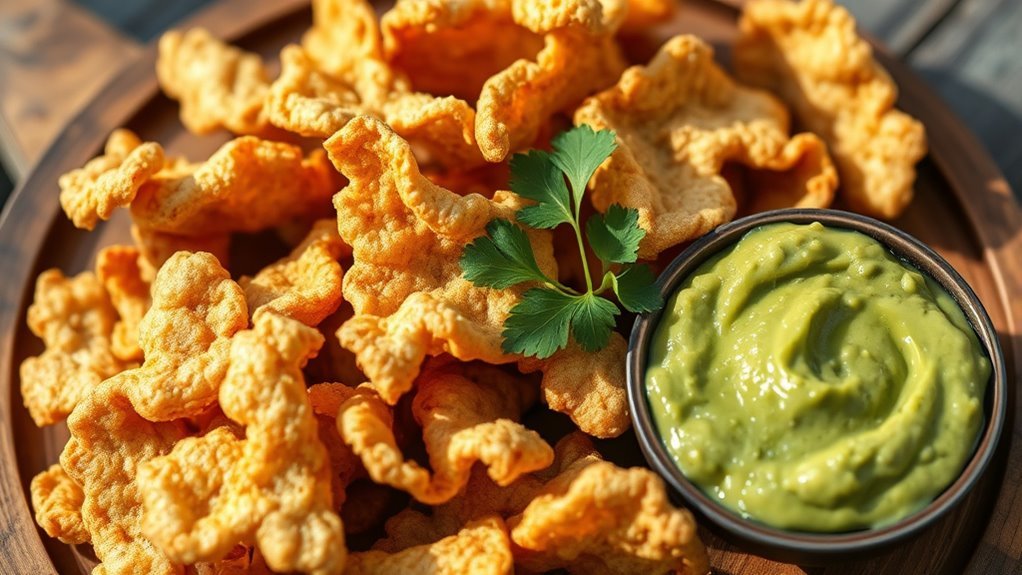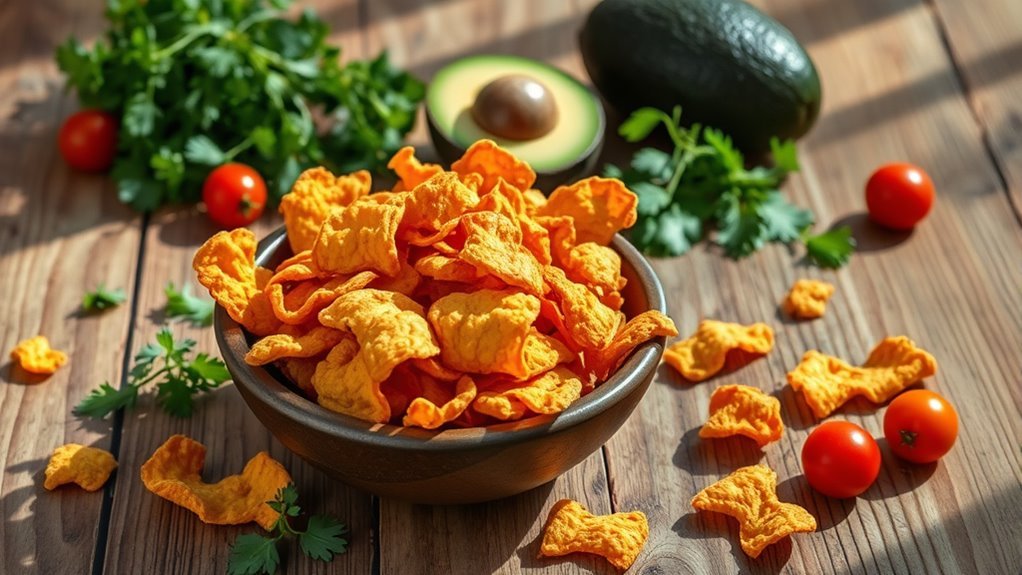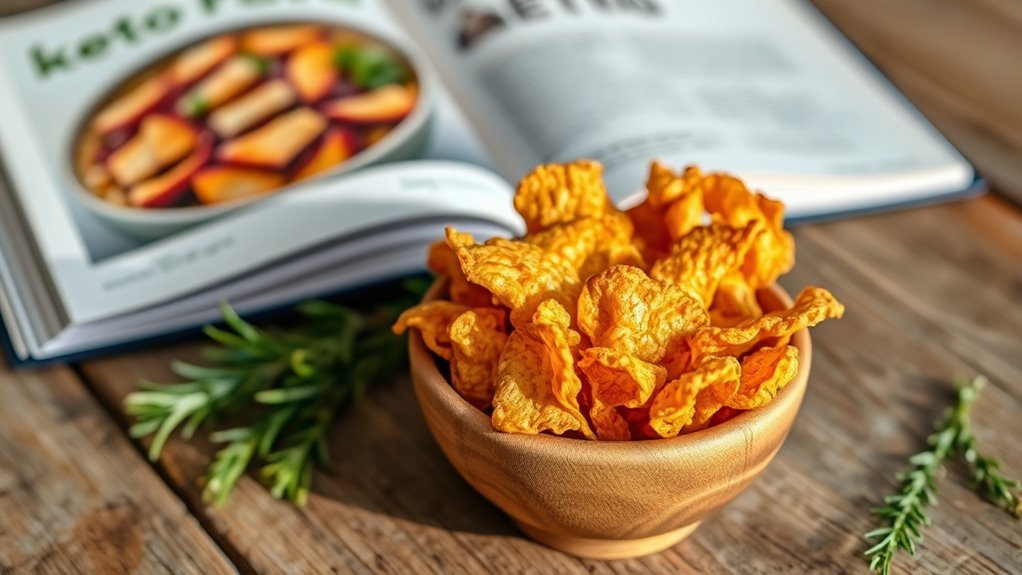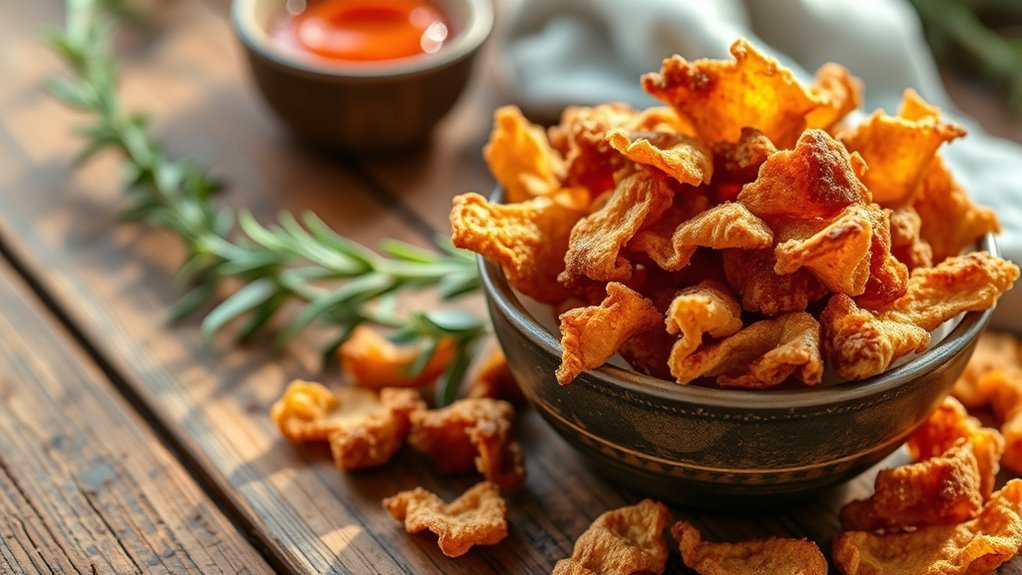Yes, pork rinds are keto-friendly. They’re high in protein and fat while being low in carbohydrates, fitting perfectly into a low-carb diet. Their versatility allows for creative uses, such as substitutions for breading or toppings. However, keep in mind their high sodium content, which can affect your health if consumed excessively. Balancing pork rinds with nutrient-dense foods is essential. There’s even more to discover about incorporating pork rinds into your meals effectively.
Nutritional Breakdown of Pork Rinds

When it comes to evaluating the nutritional profile of pork rinds, you’ll find that they pack a considerable punch. These snacks come in various pork rind varieties, which can influence their nutritional content slightly. Generally, they’re high in protein and fat while being low in carbohydrates, making them popular among those following a keto diet. The cooking methods—whether fried, baked, or air-fried—also play a role in their healthfulness, as traditional frying can add excess calories and unhealthy fats. When examining their overall nutritional breakdown, consider factors like sodium levels and any added flavors, which can impact your dietary choices. Understanding these elements will empower you to enjoy pork rinds while making informed eating decisions. Additionally, the nutritional value comparison highlights how pork rinds can offer significant health benefits compared to traditional snacks.
Health Benefits of Pork Rinds

Pork rinds offer several health benefits that make them an appealing snack choice, especially for those on a keto diet. With a high protein content and low carbohydrate levels, they can help you maintain muscle mass while supporting weight management. Additionally, the healthy fats found in pork rinds can provide sustained energy and promote satiety, making them a smart option for your snacking needs.
High Protein Content
One of the standout features of pork rinds is their impressive protein content, making them a popular choice for those following a keto diet. With a high protein quality, pork rinds provide essential amino acids necessary for muscle repair and growth. Here are some benefits you can enjoy:
- Muscle Maintenance: The protein helps maintain lean muscle mass, especially important in a low-carb diet.
- Satiety: High protein content can keep you feeling full longer, aiding in weight management.
- Metabolic Boost: Protein has a higher thermic effect, meaning it can help increase calorie burn.
- Nutrient Density: They offer a concentrated source of protein without excess carbs, aligning perfectly with keto principles.
Incorporating pork rinds into your diet can support your health goals effectively.
Low Carbohydrate Snack
As you seek low-carbohydrate snack options, pork rinds emerge as a strong contender due to their negligible carb content. Unlike many other snack varieties, pork rinds boast a unique combination of crunch and flavor that can satisfy your cravings without derailing your dietary goals. With virtually no carbohydrates, they allow you to indulge in different flavor profiles—spicy, barbecue, or even cheesy—while staying true to a keto lifestyle. Their high protein content further enhances their appeal as a satisfying snack. When compared to traditional snacks like chips or pretzels, pork rinds provide a guilt-free alternative that aligns with your low-carb objectives, making them a perfect choice for those who value both taste and health.
Healthy Fats Source
While many snacks are laden with unhealthy fats, pork rinds offer a healthier alternative that can fit seamlessly into your diet. They’re a rich source of healthy fats, making them an appealing option for those seeking nutritional sources that support a low-carb lifestyle. Here are some health benefits of incorporating pork rinds into your diet:
- High in Protein: They provide a good amount of protein, essential for muscle repair and growth.
- Low in Carbs: Perfect for a ketogenic or low-carb diet.
- Rich in Collagen: Supports skin health and joint function.
- Satiating: Their fat content helps curb your hunger, reducing the need for frequent snacking. Additionally, pork rinds can be an excellent source of healthy fats that align with ketogenic dietary goals.
Embrace the freedom of enjoying flavorful snacks without compromising your health!
How Pork Rinds Fit Into a Keto Diet

When considering snacks that align with a keto diet, pork rinds emerge as a surprisingly versatile option. These crispy treats are low in carbs and high in protein, making them an ideal choice for maintaining ketosis. You can enjoy them on their own, or incorporate them into various pork rind recipes. For instance, crushed pork rinds can serve as a breading alternative for chicken or fish, adding a satisfying crunch without the carbs. Additionally, they can be used in keto meal ideas like casseroles or as topping for salads. This flexibility allows you to indulge in flavorful meals while adhering to your diet, giving you the freedom to enjoy your culinary creations without guilt. Furthermore, high-quality meats like pork provide essential nutrients that support a healthy keto lifestyle.
Potential Drawbacks of Eating Pork Rinds
While pork rinds can be a satisfying snack on a keto diet, you should be aware of their high sodium content, which may lead to increased blood pressure if consumed in excess. Additionally, they offer low nutritional value, lacking essential vitamins and minerals that your body needs. Balancing your intake of pork rinds with more nutrient-dense foods is vital for overall health. It’s important to keep in mind that daily carb limit typically ranges from 20 to 50 grams for most individuals on a ketogenic diet.
High Sodium Content
Although pork rinds are often celebrated for their low carbohydrate content and high protein levels, their high sodium content poses potential health risks that shouldn’t be overlooked. The sodium effects on your body can disrupt hydration balance, leading to various health issues. Here are some points to evaluate:
- Increased Blood Pressure: High sodium intake can raise your blood pressure, impacting heart health.
- Dehydration Risk: Excessive sodium can lead to dehydration, especially if you’re not consuming enough water.
- Kidney Strain: Your kidneys may work harder to filter excess sodium, possibly leading to issues over time.
- Bloating: High sodium can cause water retention, leading to uncomfortable bloating. Additionally, consuming high amounts of sodium may affect insulin sensitivity and overall metabolic health.
Being aware of these factors can help you make informed choices about incorporating pork rinds into your diet.
Low Nutritional Value
Pork rinds may be a popular snack choice for those on a keto diet, but their low nutritional value raises concerns. While they’re high in protein and fat, they lack essential vitamins, minerals, and fiber, making their nutrient density quite poor. Relying heavily on pork rinds can disrupt your dietary balance, potentially leading to deficiencies in key nutrients your body needs to function effectively. It’s vital to remember that a well-rounded diet should include a variety of foods that provide the necessary nutrients. If you’re looking to maintain a keto lifestyle, consider incorporating more nutrient-dense options like avocados, leafy greens, or nuts to complement your intake of pork rinds, ensuring you meet your nutritional needs while enjoying your freedom of choice. Additionally, pairing pork rinds with healthy fats can improve overall nutrition and help maintain ketosis.
Creative Ways to Enjoy Pork Rinds
If you’re looking to elevate your snacking game, pork rinds offer a versatile canvas for creativity. Not only are they low in carbs, but they can also be transformed into delicious treats. Here are four creative ways to enjoy them:
Elevate your snacking with versatile, low-carb pork rinds that can be transformed into delicious and creative treats.
- Pork Rind Nachos: Layer pork rinds with cheese, jalapeños, and guacamole for a keto-friendly twist on nachos.
- Spicy Pork Rinds Dip: Crush spicy pork rinds and mix with cream cheese and salsa for a zesty dip.
- Coating for Fried Foods: Use crushed pork rinds as a breading for chicken or fish to maintain your keto lifestyle.
- Pork Rind Salad Topping: Sprinkle over salads for added crunch and flavor without the carbs.
These ideas not only satisfy your cravings but also keep your meals exciting! Additionally, pork rinds are a great source of healthy fats, making them a perfect complement to a low-carb diet.
Alternative Keto Snacks to Consider
What are some alternative snacks that can seamlessly fit into your keto lifestyle? Consider incorporating low carb veggies like cucumber, bell peppers, or celery, paired with high-fat dips such as guacamole or ranch dressing. These options not only satisfy cravings but also provide essential nutrients. For a sweet treat, explore keto dessert options made with almond flour or coconut flour, which allow you to indulge without the carbs. Sugar-free chocolate or fat bombs can also be delightful alternatives. Additionally, olives are low in carbs and can be a versatile addition to your snack rotation. By choosing these snacks, you maintain your keto principles while enjoying variety and flavor. Remember, the key is to balance enjoyment with nutritional value, ensuring your snack choices fuel your body and keep you satisfied throughout the day.
Frequently Asked Questions
Are Pork Rinds Gluten-Free?
Yes, pork rinds are gluten-free, making them a great snack option for those with dietary restrictions. They’re made from pig skin, which doesn’t contain gluten. However, you should always check the packaging, as some flavored varieties may include additives that could introduce gluten. If you’re looking for a crunchy, low-carb snack, pork rinds fit the bill perfectly. Just remember to enjoy them in moderation as part of a balanced diet!
Can You Make Pork Rinds at Home?
Yes, you can definitely make pork rinds at home! Imagine stepping into a rustic kitchen, the smell of sizzling pork filling the air. Using simple homemade recipes, you can transform pork skin into crunchy snacks. Common cooking techniques involve boiling the skin, seasoning it, and then deep-frying or baking until crispy. Experimenting with flavors gives you the freedom to create unique treats, satisfying your cravings while enjoying the process of crafting your own snacks.
How Are Pork Rinds Made?
Pork rinds are made by frying or baking the skin of pigs until it becomes crispy. You’ll need ingredients like pork skin, salt, and sometimes spices for flavor. The cooking methods typically involve rendering the fat from the skin, followed by cutting it into pieces and frying or baking until they puff up. This process not only creates a crunchy snack but also preserves the natural flavor of the pork, allowing for a satisfying treat.
What Is the Shelf Life of Pork Rinds?
Pork rinds typically have a shelf life of six months to a year if stored properly. To keep their freshness, you should store them in a cool, dry place, ideally in an airtight container. Freshness indicators include a crisp texture and absence of off-putting smells. If they become stale or develop an unusual odor, it’s best to discard them. Proper pork rinds storage guarantees you enjoy their crunch and flavor longer.
Are There Any Vegetarian Alternatives to Pork Rinds?
Absolutely, there are vegetarian alternatives to pork rinds! Have you considered snacks like cheese crisps or kale chips? Both are low-carb options that satisfy that crunchy craving. You might also try roasted seaweed or chickpea puffs for a unique twist. These vegetarian snacks not only offer variety but also cater to diverse diets. Exploring these alternatives can provide you with the freedom to enjoy tasty treats without compromising your dietary preferences.


